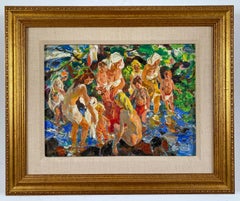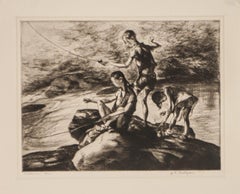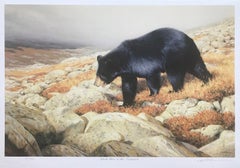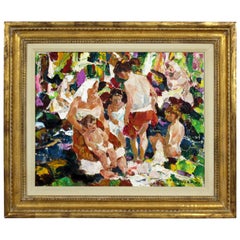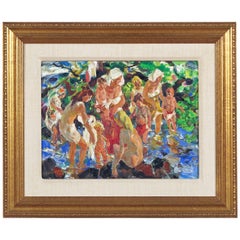John Edward Costigan Art
to
10
10
10
3
2
1
Group of Workers
By John Edward Costigan
Located in San Francisco, CA
This artwork titled "Group of Workers" 1943, is an original lithograph on paper by noted American artist John Edward Costigan, 1888-1972. It is hand signed and titled in pencil by th...
Category
Mid-20th Century Realist John Edward Costigan Art
Materials
Lithograph
Bathing Group
By John Edward Costigan
Located in Sheffield, MA
John Edward Costigan, N.A.
American, 1888-1972
Bathing Group
Oil on canvas board
Signed ‘J.E. Costigan N.A.’ lower left
12 by 16 in. W/frame 20 by 24 i...
Category
1950s Post-Impressionist John Edward Costigan Art
Materials
Oil
Cutting Foddor original 1938 etching by John Costigan
By John Edward Costigan
Located in Paonia, CO
Cutting Fodder, also known as Family in the Field, is an original signed 1938 etching by the American artist John E. Costigan ( 1888-1972 )a self-taught painter and printmaker. ...
Category
Mid-20th Century Other Art Style John Edward Costigan Art
Materials
Etching
Fisherman Three 1939 original signed etching by John E. Costigan
By John Edward Costigan
Located in Paonia, CO
Fisherman Three is an original 1939 signed etching by the American artist John E. Costigan
( 1888-1972 ) a self-taught painter and printmaker. The locale for Costigan...
Category
Mid-20th Century Other Art Style John Edward Costigan Art
Materials
Etching
Bathers
By John Edward Costigan
Located in Sheffield, MA
John Edward Costigan, N.A.
American, 1888-1972
Bathers
Oil on canvas
Signed ‘J.E. Costigan N.A.’ lower left
20 by 24 in. W/frame 26 by 30 in.
John Costigan was born of Irish-American parents in Providence, Rhode Island, February 29, 1888. He was a cousin of the noted American showman, George M. Cohan, whose parents brought the young Costigan to New York City and was instrumental in starting him on a career in the visual arts. They were less successful in encouraging him to pursue formal studies at the Art Students League (where, however, he later taught) than in exposing him to the commercial art world through the job they had gotten him with the New York lithographing firm that made their theatrical posters.
At the H. C. Miner Lithographing Company, Costigan worked his way up from his entry job as a pressroom helper, through various apprenticeships, to the position of sketch artist. In the latter capacity he was an uncredited designer of posters for the Ziegfeld Follies and for numerous silent films. Meanwhile, he had supplemented his very meager formal studies in the fine arts with a self-teaching discipline that led to his first professional recognition in 1920 with the receipt of prizes for an oil painting and watercolor in separate New York exhibitions.
A year earlier, Costigan had wed professional model Ida Blessin, with whom he established residence and began raising a family in the sleepy little rural New York hamlet of Orangeburg, the setting for the many idyllic farm landscapes and wood interiors with which he was to become identified in a career that would span half a century.
John Costigan’s first national recognition came in 1922 with his winning of the coveted Peterson Purchase prize of the Art Institute of Chicago for an oil on canvas, “Sheep at the Brook.” It marked the start of an unbroken winning streak that would gain him at least one important prize per year for the remainder of the decade. The nation’s art journalists and critics began to take notice, making him the recurring subject of newspaper features and magazine articles. The eminent author and critic Edgar Holger Cahill was just a fledgling reporter when he wrote his first feature, “John Costigan Carries the Flame,” for Shadowland Magazine in 1922. Costigan had his first one-man show of paintings at the Rehn Gallery on New York’s 5th Avenue in November, 1924, to be followed less than three years later by another at the Art Institute of Chicago. In addition, Costigan’s work has been—and continues to be included, side-by-side with that of some of America’s most high-profile artists, in museum and gallery exhibitions throughout the country. His renown had peaked in the early 1930s, by which time his work had been honored with nearly every major award then being bestowed in the fine arts and had been acquired for the permanent collections of several prestigious American museums, including New York’s Metropolitan (which only recently, in 1997, deaccessioned his “Wood Interior,” acquired in 1934).
Although Costigan’s celebrity had ebbed by the late 1930s, the Smithsonian Institution saw fit in 1937 to host an exhibition exclusively of his etchings. And, in 1941, the Corcoran Gallery (also Washington, D.C.) similarly honored him for his watercolors. (Another Washington institution, the Library of Congress, today includes 22 Costigan etchings and lithographs in its permanent print collection.)
During World War II, Costigan returned briefly to illustrating, mainly for Bluebook, a men’s pulp adventure magazine. A gradual revival of interest in his more serious work began at the end of the war, culminating in 1968 with the mounting of a 50-year Costigan retrospective at the Paine Art Center and Arboretum in Oshkosh, Wisconsin. Oils, watercolors and prints were borrowed from museums and private collections throughout the country, and the exhibition was subsequently toured nationally by the Smithsonian Institution.
John Costigan died of pneumonia in Nyack, NY, August 5, 1972, just months after receiving his final prestigious award —the Benjamin West Clinedinst Medal of the Artist’s Fellowship, Inc., presented in general recognition of his “...achievement of exceptional artistic merit...” in the various media he had mastered in the course of his career.
This painting depicts one of the artist's favorite themes --the farm family bathing...
Category
1950s Post-Impressionist John Edward Costigan Art
Materials
Oil
Woman and Child
By John Edward Costigan
Located in Sheffield, MA
John Edward Costigan, N.A.
American, 1888-1972
Woman and Child
Oil on canvas
Signed ‘J.E. Costigan N.A.’ lower left
24 by 30 in. W/frame 32 by 38 in.
John Costigan was born of Irish-American parents in Providence, Rhode Island, February 29, 1888. He was a cousin of the noted American showman, George M. Cohan, whose parents brought the young Costigan to New York City and was instrumental in starting him on a career in the visual arts. They were less successful in encouraging him to pursue formal studies at the Art Students League (where, however, he later taught) than in exposing him to the commercial art world through the job they had gotten him with the New York lithographing firm that made their theatrical posters.
At the H. C. Miner Lithographing Company, Costigan worked his way up from his entry job as a pressroom helper, through various apprenticeships, to the position of sketch artist. In the latter capacity he was an uncredited designer of posters for the Ziegfeld Follies and for numerous silent films. Meanwhile, he had supplemented his very meager formal studies in the fine arts with a self-teaching discipline that led to his first professional recognition in 1920 with the receipt of prizes for an oil painting and watercolor in separate New York exhibitions.
A year earlier, Costigan had wed professional model Ida Blessin, with whom he established residence and began raising a family in the sleepy little rural New York hamlet of Orangeburg, the setting for the many idyllic farm landscapes and wood interiors with which he was to become identified in a career that would span half a century.
John Costigan’s first national recognition came in 1922 with his winning of the coveted Peterson Purchase prize of the Art Institute of Chicago for an oil on canvas, “Sheep at the Brook.” It marked the start of an unbroken winning streak that would gain him at least one important prize per year for the remainder of the decade. The nation’s art journalists and critics began to take notice, making him the recurring subject of newspaper features and magazine articles. The eminent author and critic Edgar Holger Cahill was just a fledgling reporter when he wrote his first feature, “John Costigan Carries the Flame,” for Shadowland Magazine in 1922. Costigan had his first one-man show of paintings at the Rehn Gallery on New York’s 5th Avenue in November, 1924, to be followed less than three years later by another at the Art Institute of Chicago. In addition, Costigan’s work has been—and continues to be included, side-by-side with that of some of America’s most high-profile artists, in museum and gallery exhibitions throughout the country. His renown had peaked in the early 1930s, by which time his work had been honored with nearly every major award then being bestowed in the fine arts and had been acquired for the permanent collections of several prestigious American museums, including New York’s Metropolitan (which only recently, in 1997, deaccessioned his “Wood Interior,” acquired in 1934).
Although Costigan’s celebrity had ebbed by the late 1930s, the Smithsonian Institution saw fit in 1937 to host an exhibition exclusively of his etchings. And, in 1941, the Corcoran Gallery (also Washington, D.C.) similarly honored him for his watercolors. (Another Washington institution, the Library of Congress, today includes 22 Costigan etchings and lithographs in its permanent print collection.)
During World War II, Costigan returned briefly to illustrating, mainly for Bluebook, a men’s pulp adventure magazine. A gradual revival of interest in his more serious work began at the end of the war, culminating in 1968 with the mounting of a 50-year Costigan retrospective at the Paine Art Center and Arboretum in Oshkosh, Wisconsin. Oils, watercolors and prints were borrowed from museums and private collections throughout the country, and the exhibition was subsequently toured nationally by the Smithsonian Institution.
John Costigan died of pneumonia in Nyack, NY, August 5, 1972, just months after receiving his final prestigious award —the Benjamin West Clinedinst Medal of the Artist’s Fellowship, Inc., presented in general recognition of his “...achievement of exceptional artistic merit...” in the various media he had mastered in the course of his career.
This painting depicts one of the artist's favorite themes --the farm family bathing...
Category
1940s Post-Impressionist John Edward Costigan Art
Materials
Oil
"Boy With Cows, " Original Drypoint Etching signed by John Edward Costigan
By John Edward Costigan
Located in Milwaukee, WI
"Boy With Cows" is an original drypoint etching by John Edward Costigan. It depicts a young boy with three cows standing in a watering hole. The artist si...
Category
1930s American Realist John Edward Costigan Art
Materials
Etching, Drypoint
"Bathers" by John E. Costigan, Original Limited Edition Signed Etching
By John Edward Costigan
Located in New York, NY
This original, limited edition etching, was realized by the esteemed American artist John E. Costigan, circa 1930. He is represented in the collections of the Metropolitan Museum, th...
Category
1930s American Art Deco Vintage John Edward Costigan Art
Materials
Paper
John Edward Costigan Painting, circa 1950's - Carnival
By John Edward Costigan
Located in Phoenix, AZ
John Costigan (1888-1972) oil on canvas, circa: 1950s. In excellent condition.
Exciting Expressionist Painting of a lively Carnival Scene. Signed lower right: ''J.E. Costigan",
Tit...
Category
Mid-20th Century John Edward Costigan Art
Materials
Paint
"When Day is Done, " an Original Etching signed by John Edward Costigan
By John Edward Costigan
Located in Milwaukee, WI
"When Day is Done" is an original etching and aquatint signed lower right in pencil by the artist John Edward Costigan. It depicts a man and a woman with their young child at the end...
Category
1930s Post-Impressionist John Edward Costigan Art
Materials
Aquatint, Etching
Related Items
A ROAD LESS TRAVELED
Located in Aventura, FL
Lithograph on paper. Hand signed, titled and numbered by the artist. Edition of 350.
Artwork is in excellent condition. Certificate of Authenticity is included. All reasonable offers will be considered.
About the artist: As a self taught artist, Jake's style has developed over many years, evolving since childhood. Early in life he nurtured a bond with nature and wildlife that eventually became the basis for his artistic endeavors. Jake captures the landscape with striking compositions emphasizing light and color. Among the artist\'s favorite subjects are serene lakes, forests, and mountains of North America. Jake has enjoyed a popular following throughout the past 23 years that he has been showing, and his art continues to attract collectors throughout Canada and beyond. His art has found homes in his native province of Ontario, as well as internationally. He is honored to have collectors as far away as Japan, Dubai, Europe, as well as a growing clientele in Western Canada.
Category
1990s Realist John Edward Costigan Art
Materials
Lithograph, Paper
BLACK BEAR IN THE CHICKCHOCS
By Claudio D'Angelo
Located in Aventura, FL
Lithograph on paper. Hand signed, titled and numbered by the artist. Edition of 350.
Artwork is in excellent condition. Certificate of Authenticity is included. All reasonable o...
Category
Late 20th Century Realist John Edward Costigan Art
Materials
Lithograph, Paper
Desnudo de Frida Kahlo, Signed Lithograph by Diego Rivera
By Diego Rivera
Located in Long Island City, NY
This portrait depicts Rivera's second wife, the artist Frida Kahlo (1907-54), sitting on a bed wearing stockings and shoes and fastening rows of beads around her neck. An accident wh...
Category
1930s Realist John Edward Costigan Art
Materials
Lithograph
"Seated Nude" Impressionist Interior Scene Female Figure Oil Painting on Board
By Maryse Ducaire Roque
Located in New York, NY
A Mid-20th Century charming oil painting depicting a seated nude woman in a whimsical interior scene, Ducaire was known for her charming intimate figurative scenes portraying female ...
Category
Mid-20th Century Post-Impressionist John Edward Costigan Art
Materials
Board, Oil
H 19.25 in W 17.25 in D 1.5 in
Stuart Denyer NEAC - large English original STUDIO NUDE Oil Painting R.A. LONDON
Located in Cirencester, GB
ARTIST: Stuart Denyer NEAC (1953-) British
TITLE: "The Studio At The Royal Academy London"
SIGNED: lower right and dated 1981
MEASURES: 120cm x 89cm inclusive of frame
CONDITION...
Category
Late 20th Century Post-Impressionist John Edward Costigan Art
Materials
Oil
H 47.25 in W 35.04 in D 2.76 in
Nu allonge - Post Impressionist Nude Figurative Oil - Georges D'Espagnat
By Georges d'Espagnat
Located in Marlow, Buckinghamshire
Signed oil on panel nude circa 1920 by French post impressionist painter Georges D'Espagnat. The work depicts a nude woman laying a patch of green grass on top of a hill with a view of the valley in the distance.
Signature:
Signed lower right
Dimensions:
Framed: 16"x20"
Unframed: 9"x13"
Provenance:
A certificate of authenticity for this work is available from Mr. Jean Dominique Jacquemond upon request
Private French collection
From the beginning of his career, it was a constant concern of Georges d'Espagnet to assert his originality. His studies at the École des Arts Décoratifs, Paris, did not last very long, for he wanted immediate independence and decided to follow courses in the private academies of Montparnasse. In about 1900, he became acquainted with Maurice Denis, Bonnard and Vuillard, and his collaboration with Denis led to a renewal of religious art in France.
In 1903, d'Espagnet was one of the founders of the Salon d'Automne, and was appointed professor in charge of studios at the École des Beaux-Arts, Paris, in 1934. He illustrated a number of books: Rémy de Gourmont's Evil Prayers ( Oraisons mauvaises) (1896), The Saints of Paradise ( Les Saintes du paradis) (1898), Simone (1907), Sistine ( Sixtine) (1922); Alphonse Daudet's The Immortal ( L'Immortel) (1930); André Gide's The Pastoral Symphony ( La Symphonie pastorale); Francis Jammes' Clearings in the Sky ( Chairières dans le ciel) (1948).
D'Espagnet belongs to the group of artists who made the Courrier Français so successful. The drawings of his which are published in it are strongly expressive and some bear comparison with the designs of the great Renaissance masters. He also contributed to L'Image. He often placed cheerful nudes in a landscape, reminding us that, though he moved away from the Fauves, he retained their freedom of colour and arabesque. He painted many portraits, including those of Albert André, André Barbier, Victor Boucher, Déodat de Séverac, Albert Marque, André Marty and Albert Roussel. He also painted mural decorations, including a wall for the Palais de la Découverte (1937), the ceiling of the Victor Hugo Room in the Palais du Luxembourg (1939), a decorative panel for the Palais de Justice, Toulouse (1941) and interior decorations for private houses. His landscapes are Impressionist in inspiration, and work for a certain sobriety, an intimacy, both in their composition - one, two or three sketched figures and large open spaces - and in the choice of colours and treatment with the special hazy brushstroke that marks his style.
D'Espagnet took part in a number of annual Parisian exhibitions, including the Salon des Indépendants, the Salon de la Société Nationale des Beaux-Arts, the Salon d'Automne (from 1903 to 1949, except in special circumstances), the Salon de la Libre Ésthétique, Brussels (1899, 1901), the Berlin Secessionists (1940). He also exhibited at the first Salon de la Société de la Gravure sur Bois. Among other exhibitions were 1912, A Century of French Art ( Centenaire de l'art français), St Petersburg; 1916, Kunstverein, Winterthur; 1918, 1926, Galerie M. Bertheim, Paris; 1930, Contemporary French Art...
Category
1920s Post-Impressionist John Edward Costigan Art
Materials
Oil, Panel
"Notre Dame Place du Parvis" Parisian Street Scene with Notre Dame Oil Painting
By Emile Thysebaert
Located in New York, NY
This painting is a tremendously vivid and alive street scene of the Place du Parvis in Paris from the 20th Century by Emile Thysebaert. We can see the figures and cars fill the stree...
Category
Mid-20th Century Post-Impressionist John Edward Costigan Art
Materials
Oil, Panel
Landscape from the North of Sweden by Swedish Artist Otto Lindberg, 1926
Located in Stockholm, SE
Otto Lindberg was a Swedish artist born in Söderhamn in 1880. Lindberg was known for his landscapes and marine paintings. He studied at the Royal Academy of Fine Arts in Stockholm an...
Category
1920s Post-Impressionist John Edward Costigan Art
Materials
Canvas, Oil
Le Coucher - Post Impressionist Nude in Interior Oil Painting by Pierre de Belay
By Pierre de Belay
Located in Marlow, Buckinghamshire
Signed and dated nude figure in interior oil on canvas by French post impressionist painter Pierre De Belay. This work depicts a painting of Pierre De Belay's wife - Helene. Here she...
Category
1940s Post-Impressionist John Edward Costigan Art
Materials
Oil, Canvas
SCARCE EARLY OROZCO - CABEZA DE MUJER -
By Jose Clemente Orozco
Located in Santa Monica, CA
JOSE CLEMENTE OROZCO (1883 – 1949)
CABEZA DE MUJER, ( Woman's Head: Mexican Woman) 1929 (Orozco 9)
Lithograph, signed and numbered 23/50. in pencil. Pri...
Category
1920s Realist John Edward Costigan Art
Materials
Lithograph
1930's French Post Impressionist Signed Oil Nude Lady in Interior Setting
Located in Cirencester, Gloucestershire
Portrait of Nude in Artists Studio
French Post Impressionist, indistinctly signed
oil on canvas, unframed
dated 1939
canvas: 18 x 25.5 inches
provenance: private collection, France
...
Category
Mid-20th Century Post-Impressionist John Edward Costigan Art
Materials
Oil
No Reserve
H 18 in W 25.5 in
The Orchestra - Fauvist Figurative Nude Oil Painting by Louis Valtat
By Louis Valtat
Located in Marlow, Buckinghamshire
Signed fauvist figurative oil on panel by French painter Louis Valtat. This stunning piece depicts a nude orchestra with the conductor in the foreground. The musicians are playing ce...
Category
1920s Fauvist John Edward Costigan Art
Materials
Oil, Panel
Previously Available Items
Mid Century Modern Framed Oil Painting Canvas by John E. Costigan The Bathers
By John Edward Costigan
Located in Keego Harbor, MI
For your consideration is an outstanding, framed oil painting on canvas, "The Bathers," signed by John Edward Costigan. In excellent condition. The dimensions of the frame are 26" W ...
Category
Mid-20th Century American Mid-Century Modern John Edward Costigan Art
Materials
Canvas, Paint
H 22 in W 26 in D 1.5 in
"Bathing Group" Painting by John Edward Costigan
By John Edward Costigan
Located in Sheffield, MA
John Edward Costigan, N.A.
American, 1888-1972.
Bathing Group.
Oil on canvas board.
Signed ‘J.E. Costigan N.A.’ lower left.
Measures: 12 by 16 in. With ...
Category
1960s American Vintage John Edward Costigan Art
John Edward Costigan art for sale on 1stDibs.
Find a wide variety of authentic John Edward Costigan art available for sale on 1stDibs. You can also browse by medium to find art by John Edward Costigan in etching, oil paint, paint and more. Much of the original work by this artist or collective was created during the 20th century and is mostly associated with the Post-Impressionist style. Not every interior allows for large John Edward Costigan art, so small editions measuring 15 inches across are available. Customers who are interested in this artist might also find the work of Charles Picart le Doux, Henri Riviere, and Edwin Georgi. John Edward Costigan art prices can differ depending upon medium, time period and other attributes. On 1stDibs, the price for these items starts at $600 and tops out at $9,850, while the average work can sell for $2,100.
